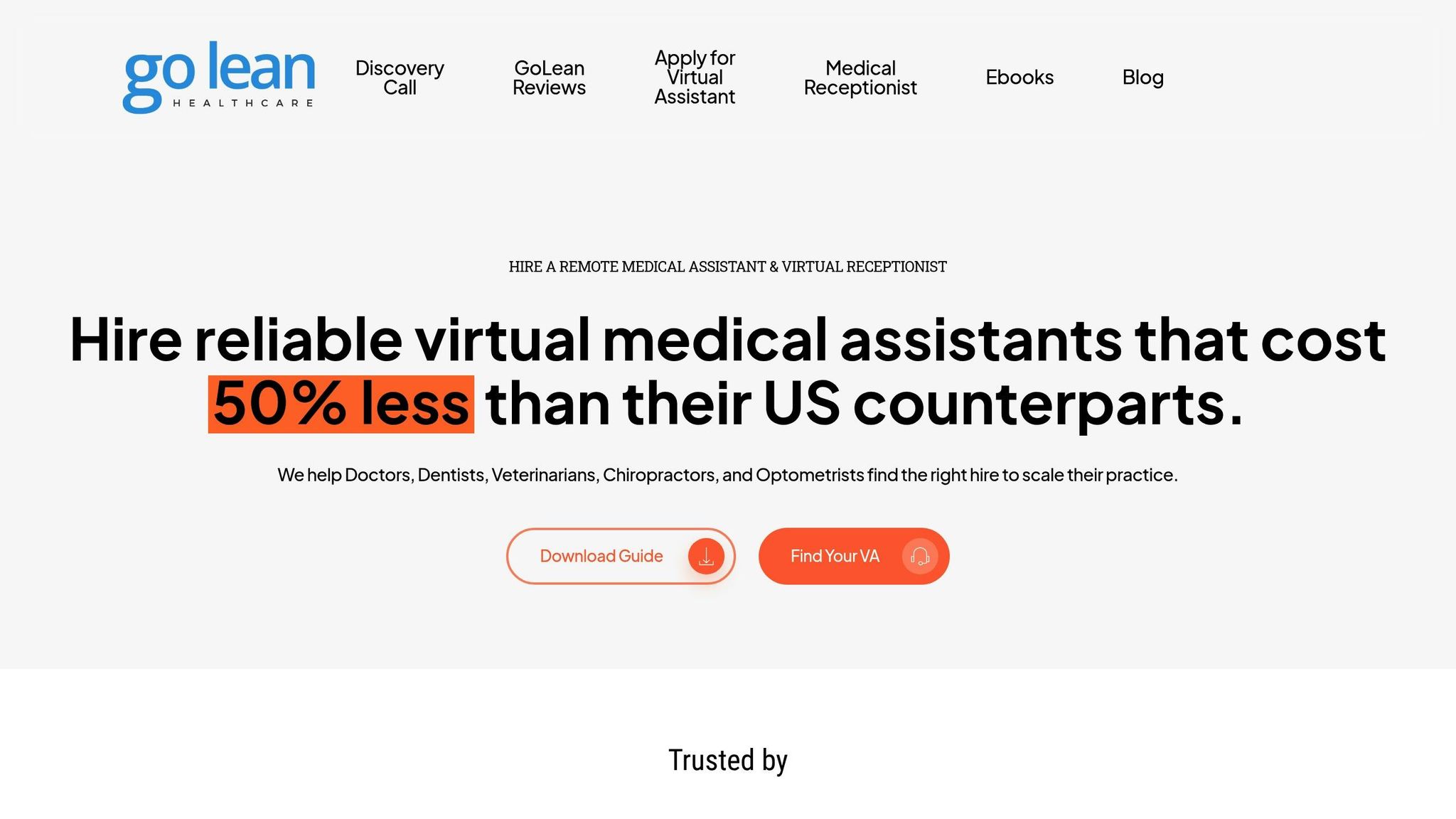Feedback is essential for improving the performance of Virtual Medical Assistants (VMAs) and ensuring high-quality patient care. Here’s how to provide effective feedback:
- Be Specific: Use measurable metrics like response times, accuracy rates, and patient satisfaction scores.
- Balance Positive and Critical Feedback: Start with recognition, address concerns constructively, and end with encouragement.
- Use Clear Communication: Opt for secure channels, document feedback, and provide actionable examples.
- Overcome Remote Challenges: Address time zone differences, cultural variations, and lack of non-verbal cues with structured solutions.
- Follow Up Regularly: Conduct daily check-ins, weekly reviews, and monthly evaluations to track progress.
Quick Overview of Feedback Steps:
- Before the Session: Gather performance data and prepare specific examples.
- During the Session: Open with positives, review performance metrics, and set SMART goals.
- After the Session: Send a summary, schedule follow-ups, and monitor improvements.
By implementing these strategies, you can enhance VMA performance, improve patient outcomes, and streamline healthcare operations.
How To Give Your Virtual Assistant Feedback To Get Them Back On Track
Core Rules for Giving Good Feedback
Providing effective feedback for Virtual Medical Assistants (VMAs) requires a structured and professional approach. Research highlights that organizations with strong feedback systems experience a 14% boost in employee performance [3]. Below are key principles to integrate this into daily practice.
Focus on Facts and Numbers
When assessing VMAs, rely on measurable metrics to ensure clarity and fairness. Instead of vague comments like "your work needs improvement", use specific performance indicators to guide feedback:
| Performance Area | Measurable Metrics | Target Goals |
|---|---|---|
| Patient Scheduling | Response time, accuracy rate | Less than 2 hours, 98% accuracy |
| EMR Documentation | Completion rate, error rate | 100% daily completion, under 1% errors |
| Communication | Patient satisfaction, follow-up rate | Over 4.5/5 rating, 95% follow-up |
Once these metrics are established, communicate the findings in a clear and professional manner.
"Feedback guides growth and builds collaborative relationships." – VirtualStaff.ph [1]
Keep Communication Clear and Professional
Clear and professional communication is key to ensuring feedback is understood and actionable. Interestingly, 70% of employees report feeling they don’t receive enough constructive feedback [3]. To improve this process:
- Use secure channels for feedback sessions.
- Document feedback in writing to reference later.
- Provide specific examples while safeguarding patient privacy.
- Address behaviors and outcomes rather than personal attributes.
Mix Positive and Critical Comments
Balancing positive feedback with constructive criticism is crucial for maintaining motivation and improving performance. Research shows that high-performing teams maintain a ratio of 5.6 positive comments for every critical one [2]. Here’s a structured approach:
- Start With Recognition
Highlight specific achievements and explain their impact. Positive reinforcement has been shown to boost productivity by 30% [3]. - Offer Targeted Solutions
Address concerns constructively by focusing on actionable solutions. For instance, instead of saying, "Your scheduling is disorganized", suggest, "Let’s try a color-coding system to streamline scheduling." - End With Encouragement
Wrap up by emphasizing the value of the assistant’s contributions and expressing confidence in their ability to improve.
Step-by-Step Feedback Guide
Research highlights that 89% of HR leaders believe regular feedback enhances performance [5]. Here’s a straightforward guide to conducting feedback sessions that drive results.
Before the Feedback Session
Start by gathering performance data – this sets the stage for meaningful feedback. Focus on recent performance metrics that align with previously established benchmarks. Here’s a quick breakdown:
| Performance Area | Data to Review | Documentation Method |
|---|---|---|
| Daily Tasks | EMR completion rates, scheduling accuracy | Performance tracking reports |
| Patient Interaction | Response times, satisfaction scores | Patient feedback surveys |
| Administrative Work | Insurance verification accuracy, billing efficiency | Quality assurance metrics |
Review this data at least 24 hours before your meeting. Take note of both achievements and areas for improvement to ensure a well-rounded discussion. Once you’re prepared, you’re ready to lead a structured and productive session.
"Regular feedback from you lets your medical virtual assistant know how they’re doing and can help them improve their performance over time." – Serena March, Author at Translation Blog
During the Feedback Session
Host feedback discussions through secure video calls using GoLean’s HIPAA-compliant communication platform. To keep the conversation effective, structure it into these key parts:
- Opening Discussion: Start on a positive note by highlighting accomplishments. Research shows that focusing solely on negatives disengages 90% of employees [4].
- Performance Review: Share specific examples of their work using screen-sharing tools to provide clarity.
- Collaborative Goal Setting: Work together to create SMART goals that align with your practice’s objectives. Record these goals in your performance tracking system for easy follow-up.
After the Feedback Session
Reinforce progress with consistent follow-up. Studies reveal that regular, strength-based feedback can reduce turnover by 14.9% [4]. Here’s a suggested timeline for follow-up actions:
| Timeline | Action Item | Purpose |
|---|---|---|
| Within 24 hours | Send a written summary | Capture key discussion points and agreed goals |
| Weekly | Quick progress check-ins | Address immediate concerns and provide support |
| Monthly | Formal review | Evaluate progress and adjust strategies as needed |
Leverage GoLean’s performance tracking tools to monitor improvements and keep detailed records of feedback conversations. This consistent follow-up not only enhances your virtual assistant’s performance but also strengthens your commitment to delivering outstanding patient care.
sbb-itb-109dad4
Tools for Better Feedback
Providing effective feedback in healthcare hinges on using tools that are not only secure but also HIPAA-compliant, ensuring the safe handling of performance metrics.
Performance Tracking Tools
Studies show that a mere 1% boost in employee engagement can lead to a 0.33% rise in patient satisfaction [6]. To achieve this, healthcare practices need reliable systems to monitor and communicate key performance metrics. Here are some essential features to look for:
| Feature | Purpose | Impact |
|---|---|---|
| Time & Attendance | Tracks work hours and schedules | Ensures adequate coverage and boosts productivity |
| Task Completion | Monitors daily administrative duties | Evaluates efficiency and accuracy |
| Quality Metrics | Tracks error rates and accuracy | Highlights areas for training and improvement |
| Patient Satisfaction | Collects feedback scores | Assesses service quality and patient experience |
When selecting tools, prioritize those with strong security measures like data encryption, access controls, audit trails, and Business Associate Agreements (BAAs). One example is GoLean, which incorporates these features to streamline feedback processes.
"Ongoing feedback helps to increase employee engagement, while scientifically validated assessments help you create development plans." – symplr [6]
Using GoLean for Feedback
GoLean simplifies performance tracking and feedback delivery through its practical features:
- Real-Time Monitoring: Provides immediate insights into task completion and response times.
- Secure Communication Channels: Facilitates confidential, well-documented discussions between team members.
- Automated Performance Reports: Delivers objective data on metrics like EMR usage, scheduling efficiency, and more.
With nearly half of U.S. healthcare workers (47%) considering leaving their roles by 2025 [6], creating a supportive and engaging work environment is more critical than ever. GoLean’s tools not only help track performance but also foster a culture of growth, ensuring virtual medical assistants feel valued and motivated to succeed.
Conclusion: Creating Good Feedback Habits
Key Takeaways
Providing effective feedback to virtual assistants requires a structured approach, clear communication, and measurable metrics. Research indicates that companies offering consistent feedback can achieve up to a 12% improvement in performance [8]. Below is a breakdown of the critical components for successful feedback:
| Feedback Component | Best Practice | Impact |
|---|---|---|
| Timing | Daily check-ins, weekly reviews | Keeps tasks on track and addresses issues early |
| Format | Combination of real-time and scheduled sessions | Covers both immediate and long-term needs |
| Documentation | Use performance tracking tools | Promotes accountability and transparency |
| Delivery | Balance positive and constructive feedback | Maintains morale and drives improvement |
By adopting these strategies, not only can virtual assistant performance improve, but patient outcomes and operational workflows can also benefit. Regular feedback fosters engagement, responsibility, and better results.
Building a Routine for Feedback
Making feedback a consistent part of your process is essential for cultivating a high-performing remote team. Regular communication is especially critical for remote administrative roles. As Debbie Vasen and Ann MacDonald emphasize, "Effective feedback in a remote workplace can make the difference in the achievement of your remote workers. Providing regular and detailed communication will keep them on task as well as productive and motivated. The more specific your communication, the more successful your message will be." [7]
To keep your team aligned and motivated, consider implementing a schedule that includes:
- Daily check-ins for quick updates and immediate concerns.
- Weekly reviews to address progress and challenges.
- Monthly goal-setting to outline clear objectives.
- Quarterly evaluations to assess long-term performance and growth.
"Leaders inspire accountability through their ability to accept responsibility before they place blame." – Courtney Lynch [8]
FAQs
How can I address cultural differences and time zone challenges when providing feedback to my virtual medical assistant?
To work effectively across different cultural backgrounds, it’s important to invest time in understanding and respecting your virtual assistant’s unique perspective. This includes being mindful of their communication style and professional expectations. Showing empathy and fostering open, respectful dialogue helps build trust and reduces the risk of misunderstandings. When offering feedback, aim to be both clear and thoughtful, ensuring your message is easy to grasp and considerate of their context.
Time zone differences can be tricky, but they’re manageable with some planning. Try to set overlapping work hours whenever possible so you can have real-time conversations. Tools like shared calendars or scheduling apps can simplify coordinating feedback sessions, keeping communication timely. For asynchronous exchanges, make sure your feedback is detailed and easy to follow, so your assistant can move forward without needing immediate clarification. Additionally, regular check-ins help keep everyone on the same page and strengthen your working relationship, even from afar.
What’s the best way to set and track SMART goals with my virtual assistant during feedback sessions?
To set and track SMART goals with your virtual assistant, make sure each goal is Specific, Measurable, Achievable, Relevant, and Time-bound. For instance, instead of a vague goal like "improve communication", you could aim for something more concrete: "increase response rate to client emails by 20% within the next 30 days." This clarity removes guesswork and establishes clear expectations.
Track progress using performance metrics like task completion rates or response times. Performance tracking tools can simplify this process, making it easier to provide timely feedback. Regular check-ins to review progress, offer constructive feedback, and celebrate milestones can help maintain motivation and build a strong, collaborative partnership.
How can I give feedback to my virtual assistant in a way that motivates them and improves their performance?
To give feedback that inspires your virtual assistant and encourages growth, start by acknowledging their strengths and highlighting what they’re doing well. This not only sets a positive tone but also shows that their efforts are appreciated.
When discussing areas for improvement, use specific examples and offer practical suggestions to help them understand exactly how they can refine their approach. Clear and actionable feedback is key to driving meaningful change.
Timing matters too. Providing feedback shortly after a success or challenge keeps it relevant and impactful. Regular check-ins and open communication can create a supportive atmosphere, making conversations about performance and development more productive. By prioritizing collaboration and clarity, you can nurture a strong and effective partnership with your virtual assistant.




